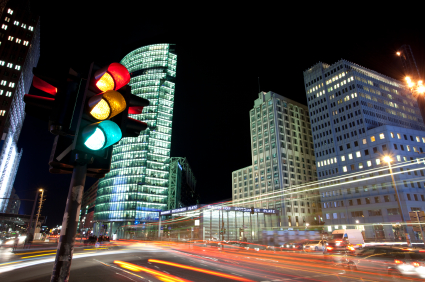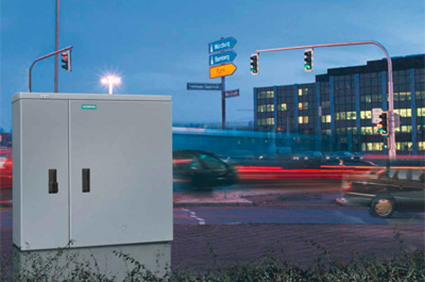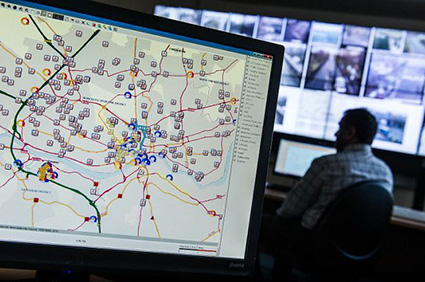Introducing a variety of traffic light control systems from simple command devices to central intelligent systems
Behineh Sanj Engineering Company, with 25 years of continuous work in the field of design and construction of various devices and intelligent command systems for traffic lights, and relying on the technical and executive ability of its personnel and up-to-date knowledge available in developed countries, has diversified services and It has taken a broad approach to improving the timing of traffic lights and traffic control, and has taken great strides in solving traffic problems at intersections and reducing delays and wasted time for drivers and passengers.
In the following, the types of advanced traffic lights control devices are introduced and compared from the practical point of view and the effect of each of them on the traffic situation.
Simple pre-time command device
Today, the simplest electronic controllers are pre-timed. In this device, based on the forecast of traffic conditions and volume during a day and night, appropriate schedules for each route are entered into the device memory in advance.
Experience has shown that in many intersections with heavy traffic volume, traffic conditions during certain hours of the day follow certain changes so that in the early morning hours, heavy traffic from residential areas to the city center and in In the last hours of the afternoon, the opposite happens. In the middle of the day, there are two modes of moderate traffic and light traffic. If these predictions are done correctly and the timing of the green light of each route is determined in proportion to the volume of traffic, these timings can be stored in the memory of the device. Days, green times corresponding to that hour of

Memory reads and executes. Experience shows that in the most advanced countries, despite the acquisition of intelligent traffic control technologies, pre-time devices still have a special place, especially when issues such as training with the device, installation costs and maintenance costs are high. It is simpler and less expensive than other devices.
In recent models of pre-time devices, it is possible to predict different patterns of scheduling for different days of the week and different weeks of the year and apply to the device so that the need to refer to the devices to change schedules during a year can also be At least reach.

Local intelligent command device
When dealing with the timing of traffic lights at an intersection, the first thing that comes to mind is that if the device can act intelligently like an experienced police force, the ideal timing can be implemented at the intersection and the times Minimize downtime. Obviously, this requires an electronic eye (sensor) on the paths leading to the intersection so that it can detect the volume of incoming or stopped traffic on each side and apply green times accordingly. Local intelligent command devices have this capability. These devices decide on the volume of traffic at any given time, and of course the accuracy of their work depends on the accuracy of the electronic eye that reads the volume of traffic.
One of the best and most common electronic eyes for traffic are sensors that are installed in the form of squares or rectangles with approximate dimensions of 2x2 meters, under the asphalt, and as each car passes over it, a
It sends pulses to the device and the green time of the light increases and decreases based on the distance of consecutive pulses, which indicates the amount of traffic congestion.
Local intelligent command devices work very well at intersections that have large fluctuations in traffic volume so that the traffic situation is not predictable, and also at intersections where one side is deserted and the other side is crowded. However, the cost of installation, operation and maintenance of these devices is much higher than the simple device, and these costs are more due to the volume of operations that are required in connection with the installation of sensors and their wiring.
In a statistical study of the impact of the intelligent system compared to the old systems that was done in one of the critical intersections of Isfahan, the rate of improvement due to the intelligent system was 25% reduction in vehicle latency at that intersection, which considering A significant reduction in fuel consumption and a reduction in people's time wastage has been significantly reduced.
Intelligent command device with the ability to connect to the control center
As cities grow and the volume of vehicles increases, the number of streets and intersections increases rapidly, and intersections become closer to each other. Proximity of intersections causes the traffic volume of an intersection to affect exactly the previous and next intersections.
Here it comes to mind that the control of individual intersections alone may no longer work, and the timing of adjacent intersections should be interconnected.
On the other hand, the growth of cities and the expansion of the traffic network strengthens the need for integrated and coordinated management of the entire city traffic. A management that considers traffic lights, public transportation, emergency vehicles, pedestrians, highways, and parking lots alongside traffic lights, and organizes all of these and other traffic-related issues together. The idea of building a transportation and urban traffic control center in the major cities of the world has become a reality over the past few decades.

In some cities, the number of intersections reaches about 2,000. In Tehran, the number of lighted intersections exceeds 1000 and is increasing rapidly. The country's metropolises are faced with more than 100 intersections, which is growing every year with significant growth. This astonishing growth can certainly not be controlled by traditional, manual and decentralized methods.
Intelligent command controllers The traffic lights at intersections in these cities must be able to connect to a command control center from the control room. The traffic police should be able to make decisions about a number of adjacent intersections at the control center at the same time.
In this case, in addition to the features of simpler devices such as pre-time, the discussion of data transfer is added.
The command from the center should reach the intersection in less than a second and be given to the lights. This requires the use of information transfer technology. Advanced smart central devices are equipped with such a system for exchanging information with the control room.
Of course, the success of using this device model also depends on how the information is transmitted. The use of dedicated telephone lines, wireless systems and, more recently, fiber optics, has allowed those involved to deliver large amounts of information at breakneck speeds to kilometers away from the center in a fraction of a second, and vice versa. , Both visually and numerically and statistically, in the center.
In the studies carried out in a number of intersections equipped with intelligent systems and the implementation of advanced phasing in lights, very interesting results have been achieved in improving the traffic process and reducing delays and delays for drivers and passengers.

Intelligent control center, control room
In the previous section, we mentioned the role of the control room as a center for controlling and deciding urban traffic. The control room is a set of computer equipment and software programs in which the experienced experts of the traffic organization and the traffic police along with representatives of traffic-related organs such as fire, bus, taxi and radio are stationed. Traffic conditions collected by electronic eyes, video sensors or CCTV cameras around the city are provided to the center's staff on multiple monitors and large screens. Also, the timing of traffic lights is sent manually or automatically from this room to the intersections. The calm and stress-free atmosphere of the control center, in contrast to the noisy, crowded and boring environment of intersections, allows traffic management to concentrate and think more and better, and naturally in such conditions, decisions will be more correct and work efficiency will be higher.
At present, in a number of major cities of the country, 2 traffic control centers have been established and are being developed. During the last 20 years, Behineh Sanj Company has been in charge of designing and executing control rooms in two big cities of Isfahan and Tabriz, and has controlled a total of 100 intersections in these two cities intelligently and centrally, and has a 25-year history in this Is the field.
Conclusion
In choosing the control and command system of traffic lights and traffic lights, it is necessary to act realistically and depending on the current situation and forecasting the future, and of course within the framework of material and budgetary facilities. As unreasonable as choosing a high-cost, intelligent traffic light controller for small, low-density intersections or sparsely populated cities, not using advanced and intelligent systems at critical intersections in large cities would be unwise. . The brief points presented here, although very brief and short, but to a large extent can help and help the urban traffic management towards the optimal and correct choice, because most of the issues raised apart from scientific and technical support and adaptation to current knowledge, based on Long and expensive experiences of the specialized and executive team of Behineh Sanj Company during the last 25 years in the country.
